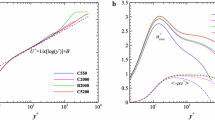Abstract
The notion of the scalar wavenumber-frequency spectrum of wall pressures is introduced, and its principal specific features are considered. A scalar wavenumber frequency spectrum representing the overall energy of all the wave component of a field of turbulent pressures with a specified wave vector module contains the brief information required for the solution of many problems of aerohydrodynamic acoustics. It is shown that loop filters enable the estimation of a wavenumber-frequency spectrum in the region of small wavenumbers. Despite the difficulty in practical implementation of scalar wave filtration of fields of turbulent pressure fluctuations, the construction of loop filters currently seems to be a promising trend of studies. The proposed methods and the results obtained in this study show that the broadband scalar wave filtration of a field of wall pressures may be performed on the basis of finite-size approximations of an “ideal” scalar wave filter with unit wave sensitivity within a specified range of wavenumbers and zero sensitivity outside this range.







Similar content being viewed by others
REFERENCES
E. B. Kudashev and L. R. Yablonik, Acoust. Phys. 67 (6), 631 (2021).
A. Yu. Golubev, E. B. Kudashev and L. R. Yablonik, Pressure Turbulent Pulsations in Acoustics and Aerodynamics (Fizmatlit, Moscow, 2019) [in Russian].
W. K. Blake, Mechanics of Flow-Induced Sound and Vibration, Vol. 2: Complex Flow-Structure Interactions, 2nd ed. (Acad. Press, 2017).
Flinovia—Flow Induced Noise and Vibration Issues and Aspects-III, Ed. by E. Ciappi, S. De Rosa, F. Franco, S. A. Hambric, R. C. K. Leung, V. Clair, L. Maxit, and N. Totaro (Springer Nature Switzerland, 2021). https://doi.org/10.1007/978-3-030-64807-7.
A. V. Smol’yakov and V. M. Tkachenko, Turbulent Pulsations Measuring (Energiya, Leningrad, 1980) [in Russian].
E. B. Kudashev and L. R. Yablonik, Near-Wall Turbulent Pressure Pulsations (Nauchnyi mir, Moscow, 2007) [in Russian].
E. B. Kudashev and L. R. Yablonik, Acoust. Phys. 66 (6), 633 (2020).
L. D. Landau and E. M. Lifshitz, Theory of Elasticity (Nauka, Moscow, 1965; Elsevier, 1986).
B. M. Efimtsov and A. Ya. Zverev, Uch. Zap. TsAGI 40 (3), 60 (2009).
B. M. Efimtsov and A. Ya. Zverev, Acoust. Phys. 58 (4), 420 (2012).
R. H. Mellen, J. Acoust. Soc. Am. 95, 1671 (1994).
B. M. Abraham and W. L. Keith, J. Fluids Eng. 120 (1), 29 (1998).
M. S. Howe, Acoustics of Fluid-Structure Interactions (Univ. Press, Cambridge, 1998).
G. N. Watson, A Treatise on the Theory of Bessel Functions (Cambridge Univ. Press, 1944; Izd. inostrannoi literatury, Moscow, 1949).
Funding
This study was supported by the Russian Foundation for Basic Research, project no. 20-02-00181 A.
Author information
Authors and Affiliations
Corresponding authors
Additional information
Translated by E. Glushachenkova
Rights and permissions
About this article
Cite this article
Kudashev, E.B., Yablonik, L.R. Models and Methods for Scalar Wave Filtration of Fields of Wall Turbulent Pressure Fluctuations. Acoust. Phys. 68, 624–631 (2022). https://doi.org/10.1134/S1063771022060070
Received:
Revised:
Accepted:
Published:
Issue Date:
DOI: https://doi.org/10.1134/S1063771022060070




